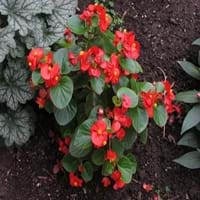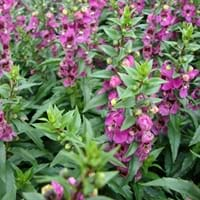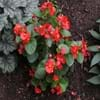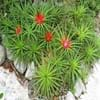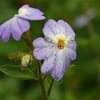Life Span
Perennial
Perennial
Type
Tender Perennial
Tender Perennial
Origin
Hybrid origin
Mexico, Caribbean
Types
Ball Red, Bicola, Brandy, Derby
Not Available
Number of Varieties
Not Available
Habitat
Subtropical climates, Tropical Climate
Mediterranean region
USDA Hardiness Zone
10-15
9-10
Sunset Zone
H1, H2, 14, 15, 16, 17, 18, 19, 20, 21, 22, 23, 24
H1, H2, 1a, 1b, 2a, 2b, 3a, 3b, 4, 5, 6, 7, 8, 9, 10, 11, 12, 13, 14, 15, 16, 17, 18, 19, 20, 21, 22, 23, 24
Habit
Clump-Forming
Upright/Erect
Flower Color
Pink, Light Pink
Purple
Flower Color Modifier
Bicolor
Not Available
Fruit Color
Not Available
Not Available
Leaf Color in Spring
Red, Burgundy, Bronze
Green
Leaf Color in Summer
Red, Burgundy, Bronze
Green
Leaf Color in Fall
Red, Burgundy, Bronze
Green
Leaf Color in Winter
Light Green
Green
Leaf Shape
Ovate
Long Linear
Plant Season
Spring, Summer, Fall, Winter
Spring, Summer, Fall
Sunlight
Full Sun, Partial Sun, Partial shade
Full Sun, Partial Sun
Type of Soil
Clay, Loam, Sand
Clay, Loam, Sand
The pH of Soil
Acidic, Neutral
Acidic, Neutral, Alkaline
Soil Drainage
Well drained
Well drained
Bloom Time
Indeterminate
Indeterminate
Tolerances
Drought
Drought
Where to Plant?
Container, Ground, Pot
Container, Ground, Pot
How to Plant?
Seedlings, stem tip cuttings
Root Division, Seedlings, Stem Cutting
Plant Maintenance
Medium
Medium
Watering Requirements
Do Not over Water, Requires regular watering
water on alternate days
In Summer
Lots of watering
Lots of watering
In Spring
Moderate
Moderate
In Winter
Average Water
Average Water
Soil pH
Acidic, Neutral
Acidic, Neutral, Alkaline
Soil Type
Clay, Loam, Sand
Clay, Loam, Sand
Soil Drainage Capacity
Well drained
Well drained
Sun Exposure
Full Sun, Partial Sun, Partial shade
Full Sun, Partial Sun
Pruning
Cut back the foliage when the plants die back naturally
Remove dead leaves
Fertilizers
Balanced, soluble fertilizer
All-Purpose Liquid Fertilizer
Pests and Diseases
Bacterial leaf spot, Blight, Powdery mildew, Stem rot
Not Available
Plant Tolerance
Drought
Drought
Flower Petal Number
Single
Single
Fragrant Bark/Stem
No
Yes
Foliage Texture
Medium
Medium
Foliage Sheen
Glossy
Matte
Attracts
Butterflies, Whiteflies
Butterflies
Allergy
Diarrhea, salivation, Swelling in mouth, Vomiting
Not Available
Aesthetic Uses
Borders, Mass in beds
Showy Purposes
Beauty Benefits
Not Available
Not Available
Environmental Uses
Air purification
Air purification
Medicinal Uses
No Medicinal Use
Not Available
Part of Plant Used
Flowers, Leaves
Whole plant
Other Uses
Used for mass plantings
Used as Ornamental plant
Used As Indoor Plant
Yes
No
Used As Outdoor Plant
Yes
Yes
Garden Design
Bedding Plant, Container, Edging, Mixed Border, Tropical
Bedding Plant, Container, Cutflower, Hanging Basket, Mixed Border, Tropical
Botanical Name
BEGONIA 'Senator Pink'
ANGELONIA angustifolia 'Car Purr09'
Common Name
Fibrous Begonia, Senator Pink Begonia, Wax Begonia
CaritaPurple 09 Angelonia, Narrowleaf Angelon, Summer Snapdragon
In Hindi
Wax Begonia
Summer Snapdragon
In German
Wachs- Begonie
Summer Snapdragon
In French
Wax Begonia
Summer Snapdragon
In Spanish
Begonia de cera
Summer Snapdragon
In Greek
Wax Begonia
Summer Snapdragon
In Portuguese
Wax Begonia
Summer Snapdragon
In Polish
Wosk Begonia
Summer Snapdragon
In Latin
Cera Begonia
Summer Snapdragon
Phylum
Magnoliophyta
Magnoliophyta
Class
Magnoliopsida
Magnoliopsida
Order
Cucurbitales
Lamiales
Family
Begoniaceae
Scrophulariaceae
Clade
Angiosperms, Eudicots, Rosids
Angiosperms, Asterids, Eudicots
Tribe
Not Available
Not Available
Subfamily
Not Available
Not Available
Number of Species
Not Available
Properties of Wax Begonia and Summer Snapdragon
Wondering what are the properties of Wax Begonia and Summer Snapdragon? We provide you with everything About Wax Begonia and Summer Snapdragon. Wax Begonia doesn't have thorns and Summer Snapdragon doesn't have thorns. Also Wax Begonia does not have fragrant flowers. Wax Begonia has allergic reactions like Diarrhea, salivation, Swelling in mouth and Vomiting and Summer Snapdragon has allergic reactions like Diarrhea, salivation, Swelling in mouth and Vomiting. Compare all the properties and characteristics of these two plants. Find out which of these plant can be used as indoor plant. If you are interested to decorate your house and garden, find out aesthetic uses, compare them and select the plant which will beautify your surrounding. Along with beautification, try comparing medicinal and edible uses of Wax Begonia and Summer Snapdragon and you can choose the plant having best and most benefits.
Season and Care of Wax Begonia and Summer Snapdragon
Season and care of Wax Begonia and Summer Snapdragon is important to know. While considering everything about Wax Begonia and Summer Snapdragon Care, growing season is an essential factor. Wax Begonia season is Spring, Summer, Fall and Winter and Summer Snapdragon season is Spring, Summer, Fall and Winter. The type of soil for Wax Begonia is Clay, Loam, Sand and for Summer Snapdragon is Clay, Loam, Sand while the PH of soil for Wax Begonia is Acidic, Neutral and for Summer Snapdragon is Acidic, Neutral, Alkaline.
Wax Begonia and Summer Snapdragon Physical Information
Wax Begonia and Summer Snapdragon physical information is very important for comparison. Wax Begonia height is 15.20 cm and width 15.20 cm whereas Summer Snapdragon height is 40.60 cm and width 35.50 cm. The color specification of Wax Begonia and Summer Snapdragon are as follows:
Wax Begonia flower color: Pink and Light Pink
Wax Begonia leaf color: Red, Burgundy and Bronze
Summer Snapdragon flower color: Purple
- Summer Snapdragon leaf color: Green
Care of Wax Begonia and Summer Snapdragon
Care of Wax Begonia and Summer Snapdragon include pruning, fertilizers, watering etc. Wax Begonia pruning is done Cut back the foliage when the plants die back naturally and Summer Snapdragon pruning is done Remove dead leaves. In summer Wax Begonia needs Lots of watering and in winter, it needs Average Water. Whereas, in summer Summer Snapdragon needs Lots of watering and in winter, it needs Average Water.
